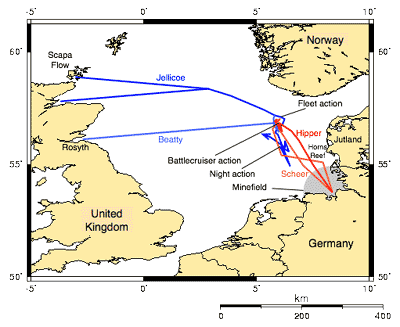Battle of Jutland
The battle of Jutland was the preeminent naval encounter of World War I, pitting the German High Seas Fleet against the British Grand Fleet in an encounter about 65 miles off the Danish coast in the Skagerrak arm of the North Sea.

On May 31, 1916 a scouting force was dispatched from British Admiral John R. Jellicoe's fleet to seek the position of the German fleet. A similar enemy scouting group was encountered, leading to an exchange of fire for nearly an hour in the late afternoon. As the main German fleet under Admiral Reinhard Scheer entered the area, the small British force mounted a delaying action until Jellicoe arrived.
The two great fleets engaged one another in the receding light and fog. After several hours of heavy shelling the Germans attempted to take advantage of the decreased visibility and withdraw. However, Jellicoe had anticipated the German move and managed to block the retreat. Scheer responded by sending his destroyers directly at the British fleet and succeeded in creating a diversion, enabling his main force to escape. Jellicoe, fearful of German torpedoes, also withdrew. Both sides claimed victory.
Performing brilliantly and taking a heavy toll among the British ships, the smaller German fleet probably won a tactical victory. The Germans lost 11 of the 110 vessels they had engaged in the encounter. Some interventionists in the U.S. thought that the Battle of Jutland threatened to end British supremacy on the seas and urged immediate entry to keep the British viable.
The British lost 14 of their 149 ships, but were the strategic victors. They forced the German fleet back into port for the remainder of the war. In doing so, the British absorbed heavy losses in the Battle of Jutland, including the sinking of three battle cruisers, the
Indefatigable, the
Queen Mary and the
Invincible.
See
World War I Time Table.
